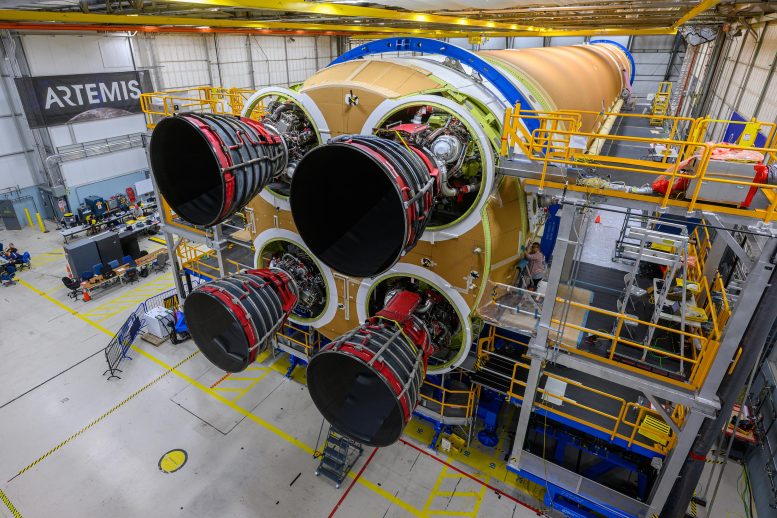
Engineers and technicians from NASA, Aerojet Rocketdyne, and Boeing at NASA’s Michoud Assembly Facility in New Orleans have installed all four RS-25 engines to the core stage for NASA’s Space Launch System rocket that will help power the first crewed Artemis mission to the Moon. The yellow core stage is seen in a horizontal position in the final assembly area at Michoud. The engines are arranged at the bottom of the rocket stage in a square pattern, like legs on a table. Credit: NASA/Eric Bordelon
NASA, partnering with Aerojet Rocketdyne and Boeing, has made significant progress on the SLS rocket for the Artemis II mission, aiming to land the first woman and person of color on the Moon.
NASA and industry partners Aerojet Rocketdyne and Boeing have installed all four RS-25 engines onto the SLS (Space Launch System) rocket core stage for the agency’s Artemis II mission, signaling the core stage is nearing completion. Once complete, the core stage will be shipped to NASA’s Kennedy Space Center in Florida. Aerojet Rocketdyne, an L3Harris Technologies company, is the lead contractor and Boeing is the core stage lead contractor.
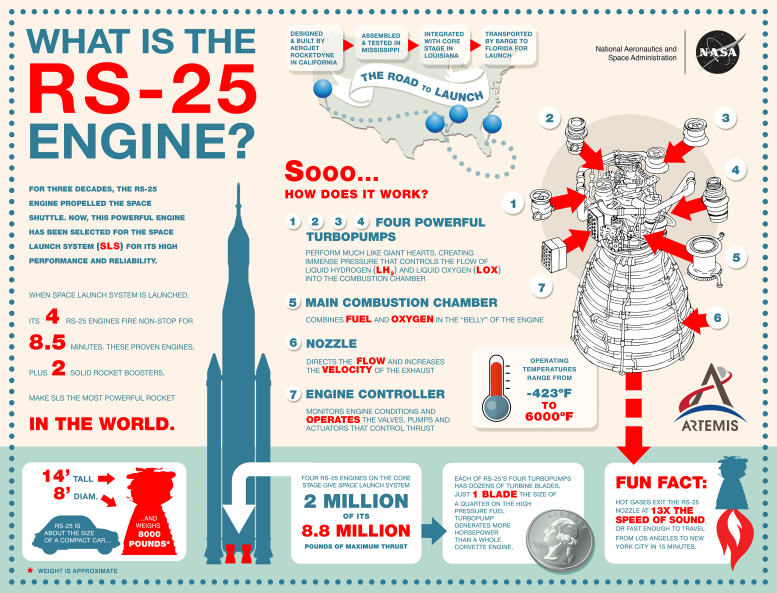
Learn everything you need to know about the RS-25 Engines that will help make SLS the most powerful rocket in the world. Credit: NASA/MSFC
The Significance of the Core Stage and Testing Phases
NASA and its partners have fully secured the four RS-25 engines onto the core stage of the agency’s SLS (Space Launch System) rocket for the Artemis II flight test. The core stage, and its engines, is the backbone of the SLS mega rocket that will power the flight test, the first crewed mission to the Moon under Artemis.
Engineers have begun final integration testing at NASA’s Michoud Assembly Facility in New Orleans, in preparation for acceptance ahead of shipment of the stage to Kennedy Space Center in Florida in the coming months.
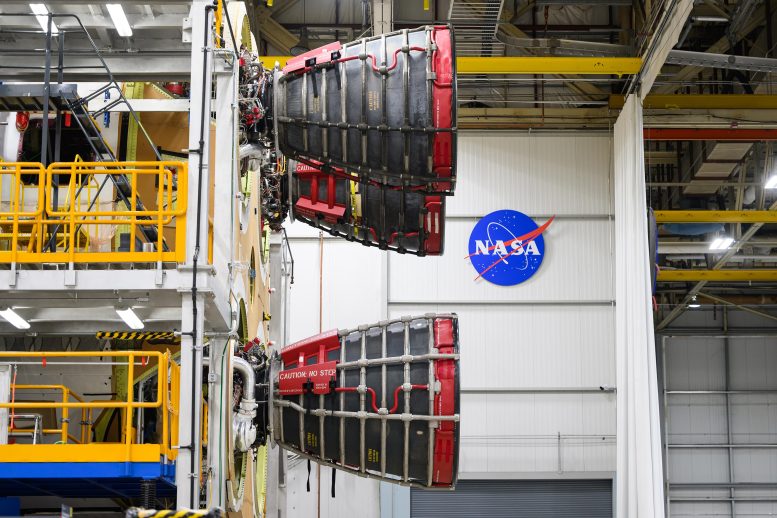
These photos show how technicians at NASA’s Michoud Assembly Facility in New Orleans installed the third and fourth RS-25 engines onto the core stage for the agency’s SLS (Space Launch System) rocket that will help power NASA’s first crewed Artemis mission to the Moon. Credit: NASA/ Eric Bordelon
“NASA integrated many lessons learned from the first-time build and assembly of the SLS core stage for Artemis I to increase efficiencies during manufacturing and cross-team collaboration with our partners for Artemis II. NASA teams in New Orleans remain focused on assembling and preparing the SLS rocket’s liquid-fueled stage to support the flight.”
— Julie Bassler, Manager of the Stages Office for the SLS Program
- These photos show how technicians at NASA’s Michoud Assembly Facility in New Orleans installed the third and fourth RS-25 engines onto the core stage for the agency’s SLS (Space Launch System) rocket that will help power NASA’s first crewed Artemis mission to the Moon. Technicians added the first engine to the SLS core stage Sept. 11. The second engine was installed onto the stage Sept. 15 with the third and fourth engines following Sept. 19 and Sept. 20. Engineers consider the engines to be “soft” mated to the rocket stage. Technicians with NASA, Aerojet Rocketdyne, an L3Harris Technologies company and the RS-25 engines lead contractor, along with Boeing, the core stage lead contractor, will now focus efforts on the complex tax of fully securing the engines to the stage and integrating the propulsion and electrical systems within the structure. NASA is working to land the first woman and first person of color on the Moon under Artemis. SLS is part of NASA’s backbone for deep space exploration, along with Orion and the Gateway in orbit around the Moon. SLS is the only rocket that can send Orion, astronauts, and supplies to the Moon in a single mission. Credit: NASA/ Eric Bordelon
- These photos and videos show how technicians at NASA’s Michoud Assembly Facility in New Orleans installed the second of four RS-25 engines onto the core stage for the agency’s SLS (Space Launch System) rocket that will help power NASA’s first crewed Artemis mission to the Moon. Crews added the second engine, with the serial number E2047 in position one, to the stage Sept. 15. The serial number for the engine installed Sept. 11 in position two on the core stage is E2059. Engineers consider the engines to be “soft” mated to the rocket stage. Following soft mate of all four engines, technicians with NASA, Aerojet Rocketdyne, an L3Harris Technologies company and the RS-25 engines lead contractor, along with Boeing, the core stage lead contractor, will fully secure the engines to the stage and integrate the propulsion and electrical systems within the structure. All four RS-25 engines are located at the base of the core stage within the engine section. NASA is working to land the first woman and first person of color on the Moon under Artemis. SLS is part of NASA’s backbone for deep space exploration, along with Orion and the Gateway in orbit around the Moon. SLS is the only rocket that can send Orion, astronauts, and supplies to the Moon in a single mission. Credit: NASA/ Michael Democker
Structural and Technical Aspects of the Core Stage
The 212-foot-tall core stage includes two massive liquid propellant tanks and four RS-25 engines at its base. For Artemis II, the core stage and its engines act as the powerhouse of the rocket, providing more than two million pounds of thrust for the first eight minutes of flight to send the crew of four astronauts inside NASA’s Orion spacecraft on an approximately 10-day mission around the Moon.
NASA, Aerojet Rocketdyne, an L3Harris Technologies company and the RS-25 engines lead contractor, along with Boeing, the core stage lead contractor, secured the engines to the maze of propulsion and avionics systems within the core stage on October 6. In the coming weeks, engineers will perform testing on the entire stage and its avionics and electrical systems, which act as the “brains” of the rocket to help control it during flight.
Once testing of the stage is complete and the hardware passes its acceptance review, the core stage will be readied for shipping to Kennedy via the agency’s Pegasus barge, based at Michoud.
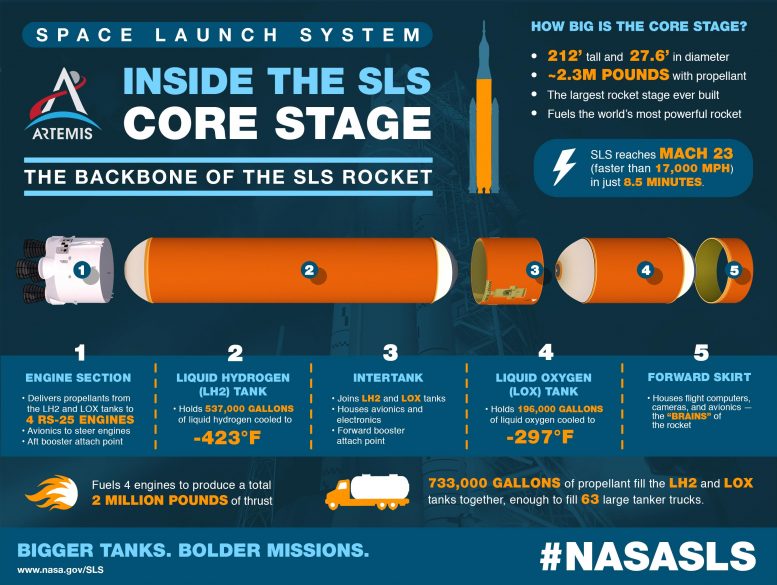
We need the biggest rocket stage ever built for the bold missions in deep space that NASA’s Space Launch System rocket will give us the capability to achieve. This infographic sums up everything you need to know about the SLS core stage, the 212-foot-tall stage that serves as the backbone of the most powerful rocket in the world. The core stage includes the liquid hydrogen tank and liquid oxygen tank that hold 733,000 gallons of propellant to power the stage’s four RS-25 engines needed for liftoff and the journey to Mars. Credit: NASA/MSFC
As teams prepare the core stage for Artemis II, rocket hardware is also under construction on our factory floor for Artemis III, IV, and V that will help send the future Artemis astronauts to the lunar South Pole.
The engines were first soft mated one by one onto the stage beginning in early September. The last RS-25 engine was structurally installed onto the stage on September 20. Installing the four engines is a multi-step, collaborative process for NASA, Boeing, and Aerojet Rocketdyne.
Following the initial structural connections of the individual engines, securing and outfitting all four engines to the stage is the lengthiest part of the engine assembly process and includes securing the thrust vector control actuators, ancillary interfaces, and remaining bolts before multiple tests and checkouts.
- These photos and videos show how technicians at NASA’s Michoud Assembly Facility in New Orleans installed the second of four RS-25 engines onto the core stage for the agency’s SLS (Space Launch System) rocket that will help power NASA’s first crewed Artemis mission to the Moon. Crews added the second engine, with the serial number E2047 in position one, to the stage Sept. 15. The serial number for the engine installed Sept. 11 in position two on the core stage is E2059. Engineers consider the engines to be “soft” mated to the rocket stage. Following soft mate of all four engines, technicians with NASA, Aerojet Rocketdyne, an L3Harris Technologies company and the RS-25 engines lead contractor, along with Boeing, the core stage lead contractor, will fully secure the engines to the stage and integrate the propulsion and electrical systems within the structure. All four RS-25 engines are located at the base of the core stage within the engine section. NASA is working to land the first woman and first person of color on the Moon under Artemis. SLS is part of NASA’s backbone for deep space exploration, along with Orion and the Gateway in orbit around the Moon. SLS is the only rocket that can send Orion, astronauts, and supplies to the Moon in a single mission. Credit: NASA/ Michael Democker
- These photos and videos show how technicians at NASA’s Michoud Assembly Facility in New Orleans installed the second of four RS-25 engines onto the core stage for the agency’s SLS (Space Launch System) rocket that will help power NASA’s first crewed Artemis mission to the Moon. Crews added the second engine, with the serial number E2047 in position one, to the stage Sept. 15. The serial number for the engine installed Sept. 11 in position two on the core stage is E2059. Engineers consider the engines to be “soft” mated to the rocket stage. Following soft mate of all four engines, technicians with NASA, Aerojet Rocketdyne, an L3Harris Technologies company and the RS-25 engines lead contractor, along with Boeing, the core stage lead contractor, will fully secure the engines to the stage and integrate the propulsion and electrical systems within the structure. All four RS-25 engines are located at the base of the core stage within the engine section. NASA is working to land the first woman and first person of color on the Moon under Artemis. SLS is part of NASA’s backbone for deep space exploration, along with Orion and the Gateway in orbit around the Moon. SLS is the only rocket that can send Orion, astronauts, and supplies to the Moon in a single mission. Credit: NASA/ Eric Bordelon
All major hardware elements for the SLS rocket that will launch Artemis II are either complete or in progress. The major components for the rocket’s two solid rocket boosters are at Kennedy. The rocket’s two adapters, produced at Marshall, along with the rocket’s upper stage, currently at lead contractor United Launch Alliance’s facility in Florida near Kennedy, will be prepared for shipment in the spring.
NASA is working to land the first woman and first person of color on the Moon under Artemis. SLS is part of NASA’s backbone for deep space exploration, along with Orion and the Gateway in orbit around the Moon, and commercial human landing systems. SLS is the only rocket that can send Orion, astronauts, and supplies to the Moon in a single mission.

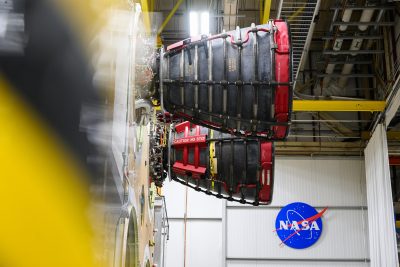
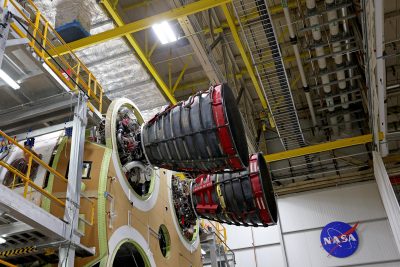
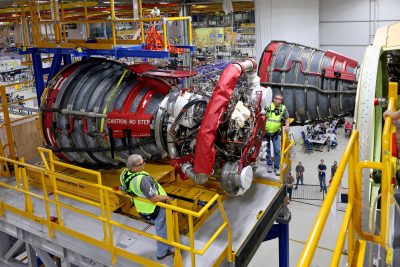
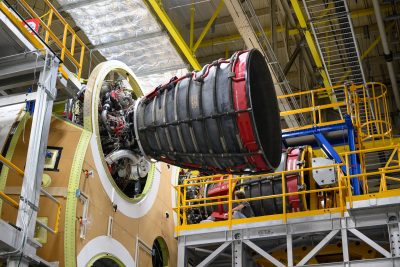








Be the first to comment on "Rocketing to the Moon: NASA’s Artemis II Core Stage Nears Final Assembly"